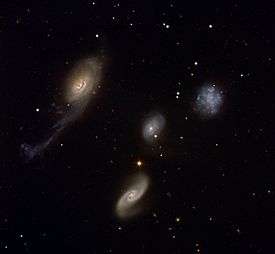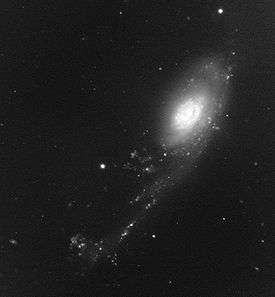Robert's Quartet
| Robert's Quartet | |
|---|---|
 | |
| Observation data (Epoch J2000) | |
| Constellation(s) | Phoenix |
| Right ascension | 0h 21m 23.075s |
| Declination | −48° 37.75′ 39.5″ |
| Brightest member | NGC 92 |
| Number of galaxies | 4 |
| Other designations | |
| AM 0018-485 | |
Robert's Quartet is a compact galaxy group approximately 160 million light-years away in the constellation Phoenix. It is a family of four very different galaxies in the process of colliding and merging. Its members are NGC 87, NGC 88, NGC 89 and NGC 92, discovered by John Herschel on the 30 September 1834.[1]
The quartet is one of the best examples of compact galaxy groups, because such groups contain four to eight galaxies in a very small region. They are excellent laboratories for the study of galactic interactions and their effects, in particular on the formation of stars. The quartet has a total visual magnitude of almost 13. The brightest member of the group is NGC 92, having the blue magnitude of 13.8.[2] On the sky, the four galaxies are all within a circle of radius of 1.6 arcmin, corresponding to about 75,000 light-years. It was named by Halton Arp and Barry F. Madore, who compiled A Catalogue of Southern Peculiar Galaxies and Associations in 1987.
Members
| Name | Type | Distance from Sun (million ly) |
Magnitude |
|---|---|---|---|
| NGC 87 | IBm pec. | ~160 | +14.5 |
| NGC 88 | SB(rs)a pec. | ~160 | +15.21 |
| NGC 89 | SB0(s)a pec. | ~160 | +14.57 |
| NGC 92 | SAa pec. | ~160 | +14.29 |

References
- ↑ Herschel, John Frederick William (1847). Results of astronomical observations made during the years 1834, 5, 6, 7, 8, at the Cape of Good Hope: being the completion of a telescopic survey of the whole surface of the visible heavens, commenced in 1825. 1. London, United Kingdom: Smith, Elder and Co. p. 51.
- ↑ "NGC 92". SIMBAD. Centre de données astronomiques de Strasbourg. Retrieved 2017-09-24.
See also
External links
- ESo: Cosmic Portrait of a Perturbed Family
- "What's In A Name?"
- Robert's Quartet on WikiSky: DSS2, SDSS, GALEX, IRAS, Hydrogen α, X-Ray, Astrophoto, Sky Map, Articles and images